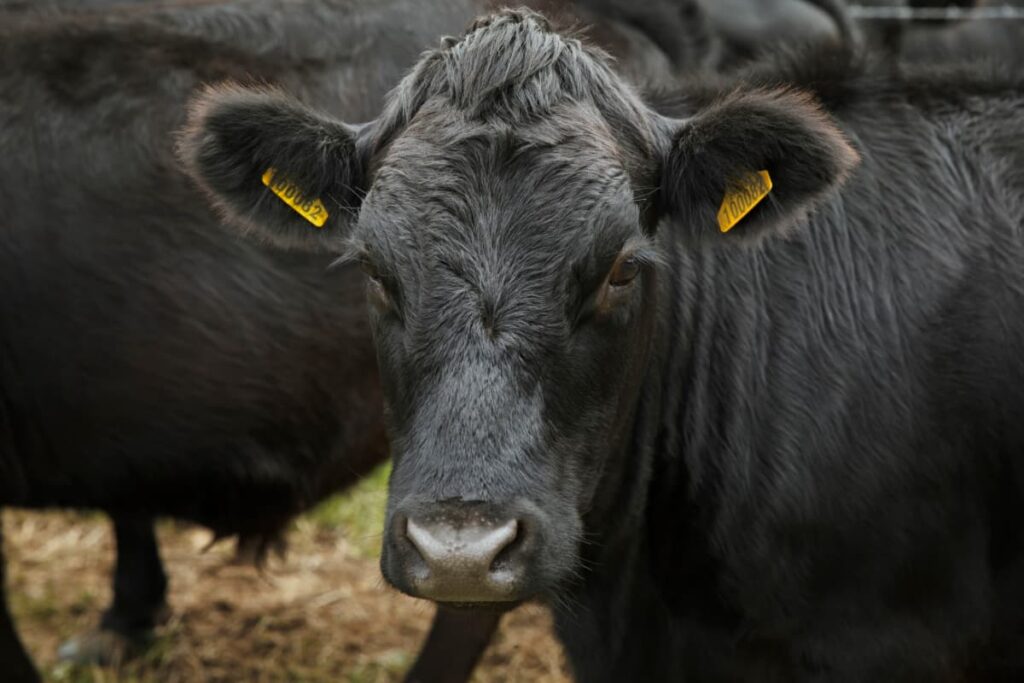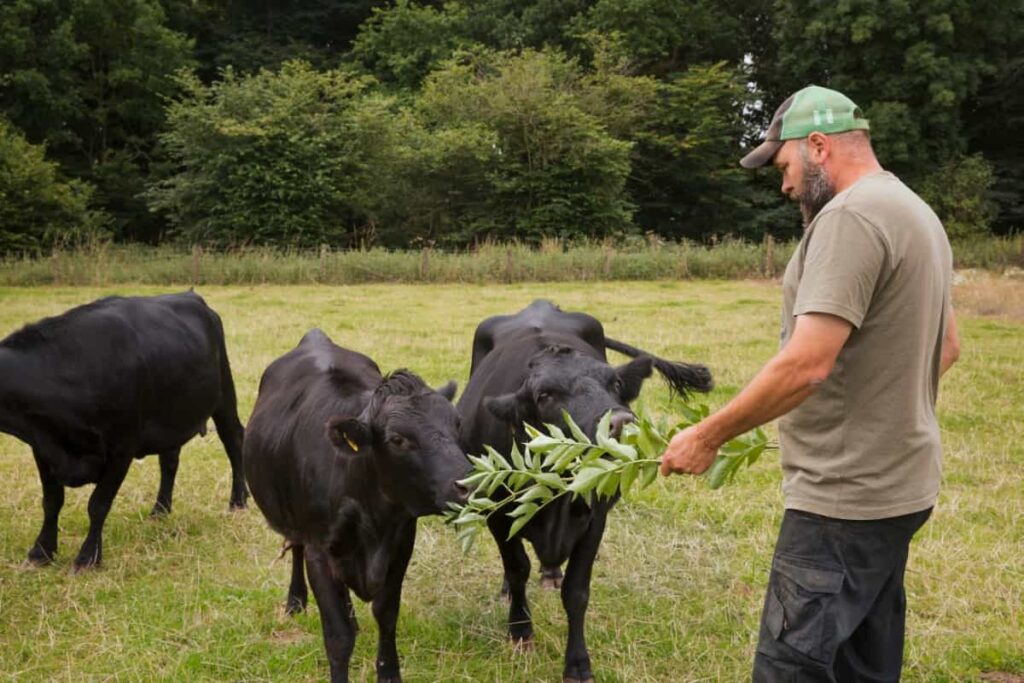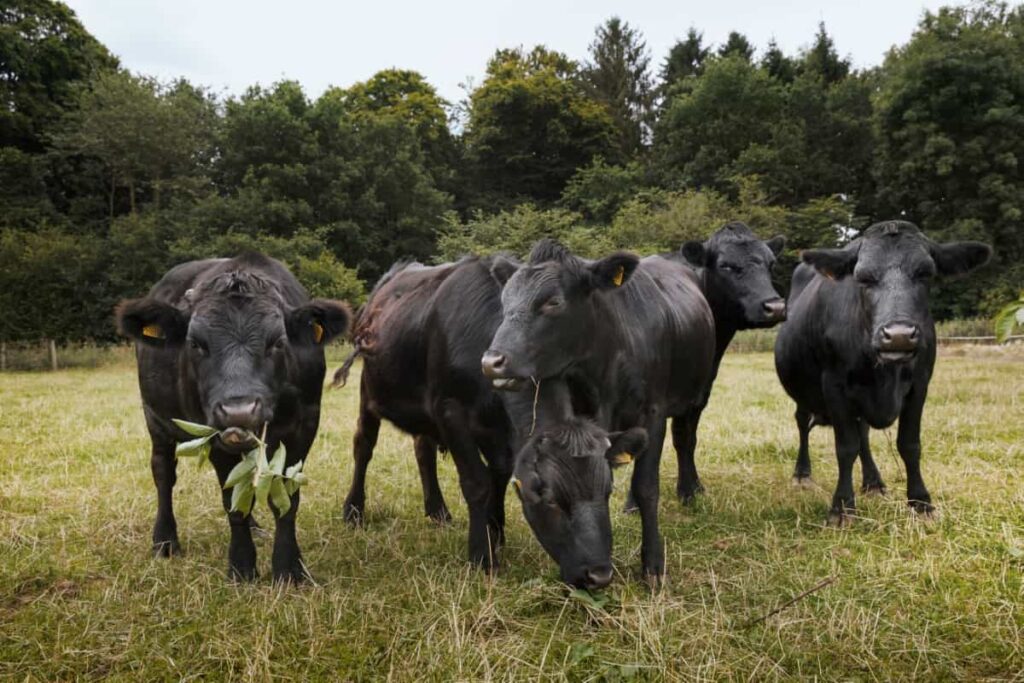Dexter cattle, a small and hardy breed originating from Ireland, have gained popularity worldwide for their manageable size, versatile uses, and gentle disposition. These compact animals, ideally suited for small farms and homesteads, boast distinctive characteristics, including dual-purpose utility, efficient feed conversion, and adaptability to various climates. Below, we delve into a comprehensive Dexter cattle overview, encompassing their characteristics, uses, disadvantages, dietary needs, weight, and pricing considerations.

Overview of Dexter Cattle Breed: Physical Characteristics and Behaviors
Dexter Cattle Characteristics
- Heritage Dexter cows are small-sized cattle, making them ideal for small farms and homesteads.
- They possess a wide and deep body with well-rounded hindquarters, contributing to their sturdy appearance.
- When it comes to dexter cattle color, Dexters come in three primary colors: red, brown, and black. They typically have minimal white markings, primarily on the belly/udder area and occasionally on the tail switch.
- They can either be horned or polled. Horned Dexters have small, thick horns that grow upward with a slight curve, pointing forward in bulls and upward in cows.
- These cattle have relatively short legs, adding to their compact build.
- Mature cows weigh approximately 350 kg on average, while mature bulls weigh around 450 kg.
Behaviors
- Dexters are known for their docile and friendly nature, making them easy to handle, especially for beginners.
- They exhibit a high level of hardiness and adaptability to various climates and environmental conditions.
- Dexters are efficient grazers, capable of thriving on pasture-based diets, which makes them suitable for sustainable agriculture practices.
- They demonstrate strong maternal instincts, often exhibiting attentive care towards their calves.
- Dexters typically exhibit social behaviors within their herd, forming cohesive groups and hierarchies.
The History of Dexter Cattle: Where They Come From (Origin)
Dexter cow history has their origins in the rugged landscapes of Ireland, particularly in the southern regions, where smallholder farmers bred them for centuries. Developed during the early 19th century, Dexters were primarily utilized as multi-purpose animals, valued for their ability to provide both meat and milk within limited farming spaces.
Their compact size and efficient grazing abilities made them well-suited for the small, fragmented fields common in Ireland at the time. Initially known as “Kerry cattle” or “Irish Kerry cattle,” Dexters gained prominence due to their resilience and adaptability to the harsh Irish climate and terrain. The breed’s name transitioned to “Dexter” in the late 19th century, likely derived from the area of origin in County Kerry.
Dexter Cattle Today: Their Use in Farms
Today, Dexter cattle continue to be valued for their versatility and practicality on farms around the world, particularly on small-scale operations and homesteads. Their compact size and efficient feed conversion make them well-suited for limited grazing areas, making them popular choices for sustainable agriculture practices.
On modern farms, Dexters are utilized for various purposes. They provide both high-quality meat and milk, making them economical choices for farmers seeking self-sufficiency. Their docile nature and manageable size make Dexters ideal for educational programs and youth livestock projects.
Dexter Cattle vs. Other Small Cows: What’s Different
Versatility: Dexter cattle are renowned for their dual-purpose utility, providing both high-quality meat and milk production. While other small cow breeds may excel in one area, such as milk production in Jerseys or beef production in Lowline Angus, Dexters offers a balanced approach suitable for small-scale farming operations.
Hardiness: Dexters exhibit exceptional hardiness and adaptability to various climates and environmental conditions, making them resilient to harsh weather and challenging terrains. This resilience is often unmatched by other small cow breeds.
Gentle Temperament: Dexters are known for their docile and friendly nature and are easy to handle, especially for beginners. While temperament can vary among individual animals, Dexters generally have a reputation for being calm and manageable.
Historical Significance: With origins dating back centuries, Dexters carry a rich heritage and historical significance, which adds to their appeal for farmers seeking to preserve traditional livestock breeds. Other small cow breeds may lack the same depth of history and cultural significance.
Benefits of Dexter Cattle Meat and Milk
Dexter Cattle Meat Quality: As one of the Dexter cattle benefits, Dexter beef is renowned for its exceptional tenderness, flavor, and marbling. The meat boasts a rich, beefy flavor that is highly sought after by discerning consumers. Additionally, Dexter beef tends to be leaner compared to larger beef breeds, making it a healthier option.
Dexter Cattle Milk Production: Dexter cows produce milk of excellent quality, rich in butterfat and protein. Although their milk yield may be lower compared to larger dairy breeds, Dexter milk is prized for its creamy texture and flavorful taste. It is ideal for making artisanal cheeses, butter, and other dairy products.
Raising Dexter Cows
- Provide ample space for grazing and exercise, along with sturdy shelters to protect them from harsh weather conditions.
- Implement rotational grazing practices to ensure access to fresh forage and prevent overgrazing. Dexter cattle thrive on a diet primarily composed of grass and hay.
- Supplement their diet with high-quality hay, mineral supplements, and, if necessary, grain to meet their nutritional requirements, especially during winter months or when pasture quality is low.
- Schedule regular vaccinations, deworming, and health checks with a veterinarian to maintain their well-being. Trim their hooves as needed and provide adequate parasite control.
- Provide constant access to clean, fresh water to keep them hydrated and healthy.
- Dexter cattle are generally docile but still require proper handling and training to build trust and manage them safely. Spend time with them regularly to familiarize them with human interaction.
Dexter Cattle Breeding
- For Dexter cattle breeding, choose breeding animals with good conformation, temperament, and health. Consider factors such as size, color, horn type, and milk/meat production to align with your breeding goals.
- Keep detailed records of each animal’s pedigree to track lineage and genetic traits. This helps in making informed breeding decisions to avoid inbreeding and promote genetic diversity.
- Decide on breeding methods, such as natural mating or artificial insemination, based on your resources and goals. Consider using proven sires with desirable traits to improve the quality of offspring.
- Provide appropriate Dexter cow care and monitoring during calving for the health and safety of both cow and calf. Address any complications promptly to minimize risks.
In case you missed it: Common Dairy Cattle Diseases, Symptoms, and Treatment: Check How this Guide Helps Dairy Farmers

Dexter Cattle Diet
Dexter cattle thrive on a diet primarily composed of grass and forage. Their diet should consist mainly of high-quality pasture supplemented with hay, especially during the winter months or when pasture quality is insufficient. Provide access to fresh, clean water at all times to ensure proper hydration and digestion.
Also, Dexter cattle may benefit from mineral supplements to meet their nutritional needs, particularly if deficiencies are observed in the local soil or forage. Avoid overfeeding grains, as Dexters are efficient grazers and may become overweight or develop digestive issues if fed excessively rich diets.
Dexter Cattle Weight Chart Table
| Age (Years) | Average Weight (Male) | Average Weight (Female) | |
| Birth | 20-30 kg | 20-30 kg | |
| 6 | 100-150 kg | 100-150 kg | |
| 12 | 200-250 kg | 200-250 kg | |
| 18 | 275-350 kg | 250-325 kg | |
| 24 | 350-450 kg | 300-400 kg | |
Dexter Cattle Size
Dexter cattle are small-sized cattle known for their compact build, typically the size of Dexter cattle standing at around 36 to 42 inches tall at the shoulder for cows and slightly taller for bulls.
Dexter Cattle Price Range
The price of Dexter cattle ranges from around $1500 to $2000 for a Dexter cow. These compact, dual-purpose animals are known for their efficiency in small-scale Dexter Cattle farm management. With their manageable size and good-natured temperament, Dexters offers a cost-effective solution for homesteaders seeking quality beef and dairy products.
Dexter Cattle Disadvantages
- Limited Size: Their small stature may result in lower meat and milk yields compared to larger breeds, potentially affecting profitability for commercial operations.
- Slow Growth: Dexters tend to grow at a slower rate compared to larger beef breeds, requiring more time and resources to reach market weight.
- Market Demand: Despite their excellent qualities, the market demand for Dexter beef and milk may be limited compared to more mainstream breeds, potentially impacting sales and profitability.
In case you missed it: Maximizing Profitability through Precision Livestock Management for Cattle Farms

Conclusion
In conclusion, Dexter cattle offer a unique blend of qualities, making them valuable additions to small farms and homesteads. Their compact size, gentle temperament, and dual-purpose utility make them ideal for sustainable agriculture. However, challenges such as limited size, slower growth, and market demand must be considered alongside their many advantages when deciding to incorporate Dexters into farming endeavors.
- Aquaponic Farming at Home: A Step-By-Step Guide
- Profitable Village Farming Business Ideas in 2024
- High-Yield Aquaculture: Fast-Growing Fish for Farming
- Effective Fish Pond Construction Techniques for Beginners
- Irrigation and Water Management in Pineapple Farming
- Blossom to Harvest: Mastering Flowering and Pollination in Papaya Farming
- Pig Fattening Essentials: From Selection to Sale for Beginners
- Raising Wagyu Cattle: A Complete Guide for Premium Beef Production
- Soil Types and Their Water Holding Capacity
